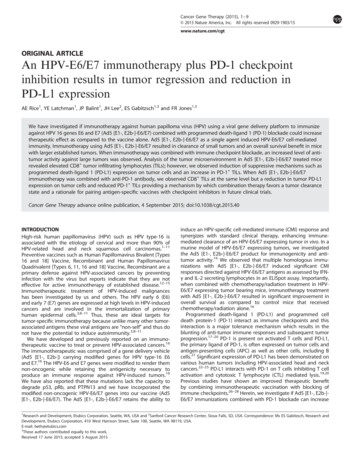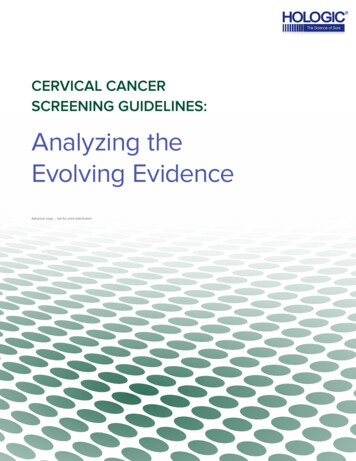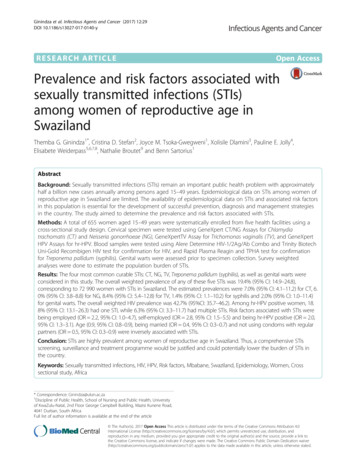
Transcription
Cancer Gene Therapy (2015), 1–9 2015 Nature America, Inc. All rights reserved 0929-1903/15www.nature.com/cgtORIGINAL ARTICLEAn HPV-E6/E7 immunotherapy plus PD-1 checkpointinhibition results in tumor regression and reduction inPD-L1 expressionAE Rice1, YE Latchman1, JP Balint1, JH Lee2, ES Gabitzsch1,3 and FR Jones1,3We have investigated if immunotherapy against human papilloma virus (HPV) using a viral gene delivery platform to immunizeagainst HPV 16 genes E6 and E7 (Ad5 [E1-, E2b-]-E6/E7) combined with programmed death-ligand 1 (PD-1) blockade could increasetherapeutic effect as compared to the vaccine alone. Ad5 [E1-, E2b-]-E6/E7 as a single agent induced HPV-E6/E7 cell-mediatedimmunity. Immunotherapy using Ad5 [E1-, E2b-]-E6/E7 resulted in clearance of small tumors and an overall survival benefit in micewith larger established tumors. When immunotherapy was combined with immune checkpoint blockade, an increased level of antitumor activity against large tumors was observed. Analysis of the tumor microenvironment in Ad5 [E1-, E2b-]-E6/E7 treated micerevealed elevated CD8 tumor infiltrating lymphocytes (TILs); however, we observed induction of suppressive mechanisms such asprogrammed death-ligand 1 (PD-L1) expression on tumor cells and an increase in PD-1 TILs. When Ad5 [E1-, E2b-]-E6/E7immunotherapy was combined with anti-PD-1 antibody, we observed CD8 TILs at the same level but a reduction in tumor PD-L1expression on tumor cells and reduced PD-1 TILs providing a mechanism by which combination therapy favors a tumor clearancestate and a rationale for pairing antigen-specific vaccines with checkpoint inhibitors in future clinical trials.Cancer Gene Therapy advance online publication, 4 September 2015; doi:10.1038/cgt.2015.40INTRODUCTIONHigh-risk human papillomavirus (HPV) such as HPV type-16 isassociated with the etiology of cervical and more than 90% ofHPV-related head and neck squamous cell carcinomas.1–11Preventive vaccines such as Human Papillomavirus Bivalent [Types16 and 18] Vaccine, Recombinant and Human PapillomavirusQuadrivalent [Types 6, 11, 16 and 18] Vaccine, Recombinant are aprimary defense against HPV-associated cancers by preventinginfection with the virus but reports indicate that they are noteffective for active immunotherapy of established disease.12–15Immunotherapeutic treatment of HPV-induced malignanceshas been investigated by us and others. The HPV early 6 (E6)and early 7 (E7) genes are expressed at high levels in HPV-inducedcancers and are involved in the immortalization of primaryhuman epidermal cells.3,8–11 Thus, these are ideal targets fortumor-specific immunotherapy because unlike many other tumorassociated antigens these viral antigens are “non-self” and thus donot have the potential to induce autoimmunity.3,8–11We have developed and previously reported on an immunotherapeutic vaccine to treat or prevent HPV-associated cancers.16The immunotherapeutic was comprised of a gene delivery vehicle(Ad5 [E1-, E2b-]) carrying modified genes for HPV type-16 E6and E7.16 The HPV-E6 and E7 genes were modified to render themnon-oncogenic while retaining the antigenicity necessary toproduce an immune response against HPV-induced tumors.16We have also reported that these mutations lack the capacity todegrade p53, pRb, and PTPN13 and we have incorporated themodified non-oncogenic HPV-E6/E7 genes into our vaccine (Ad5[E1-, E2b-]-E6/E7). The Ad5 [E1-, E2b-]-E6/E7 retains the ability toinduce an HPV-specific cell-mediated immune (CMI) response andsynergizes with standard clinical therapy, enhancing immunemediated clearance of an HPV-E6/E7 expressing tumor in vivo. In amurine model of HPV-E6/E7 expressing tumors, we investigatedthe Ad5 [E1-, E2b-]-E6/E7 product for immunogenicity and antitumor activity.16 We observed that multiple homologous immunizations with Ad5 [E1-, E2b-]-E6/E7 induced significant CMIresponses directed against HPV-E6/E7 antigens as assessed by IFNγ and IL-2 secreting lymphocytes in an ELISpot assay. Importantly,when combined with chemotherapy/radiation treatment in HPVE6/E7 expressing tumor bearing mice, immunotherapy treatmentwith Ad5 [E1-, E2b-]-E6/E7 resulted in significant improvement inoverall survival as compared to control mice that receivedchemotherapy/radiation alone.16Programmed death-ligand 1 (PD-L1) and programmed celldeath protein-1 (PD-1) interact as immune checkpoints and thisinteraction is a major tolerance mechanism which results in theblunting of anti-tumor immune responses and subsequent tumorprogression.17–20 PD-1 is present on activated T cells and PD-L1,the primary ligand of PD-1, is often expressed on tumor cells andantigen-presenting cells (APC) as well as other cells, including Bcells.21 Significant expression of PD-L1 has been demonstrated onvarious human tumors including HPV-associated head and neckcancers.22–25 PD-L1 interacts with PD-1 on T cells inhibiting T cellactivation and cytotoxic T lymphocyte (CTL) mediated lysis.19,20Previous studies have shown an improved therapeutic benefitby combining immunotherapeutic vaccination with blocking ofimmune checkpoints.26–28 Herein, we investigate if Ad5 [E1-, E2b-]E6/E7 immunizations combined with PD-1 blockade can increase1Research and Development, Etubics Corporation, Seattle, WA, USA and 2Sanford Cancer Research Center, Sioux Falls, SD, USA. Correspondence: Ms ES Gabitzsch, Research andDevelopment, Etubics Corporation, 410 West Harrison Street, Suite 100, Seattle, WA 98119, USA.E-mail: beth@etubics.com3These authors contributed equally to this work.Received 17 June 2015; accepted 5 August 2015
HPV vaccine plus PD-1 blockade results in tumor regressionAE Rice et al2an anti-tumor effect. Also, we further characterize the CMIresponse induced by the Ad5 [E1-, E2b-]-E6/E7 vaccine anddetermine the kinetics of an anti-tumor response to evaluate thetherapeutic potential of treating small versus large establishedtumors. To investigate a possible mechanism of action, weevaluate the relationship between the levels of effector T cellsand suppressor T cells within the parenchyma of the tumor andcharacterize lymphocyte populations and expression of coinhibitory molecules that may play a role in the observed antitumor responses.METHODSMiceSpecific pathogen-free (SPF), female C57BL/6 mice (Charles RiverLaboratories, Wilmington, MA) aged 8–10 weeks were housed in animalfacilities at the Infectious Disease Research Institute (IDRI) (Seattle, WA,USA). All procedures were conducted according to Institutional AnimalCare and Usage Committee (IACUC) approved protocols.Viral constructionAd5 [E1-, E2b-]-E6/E7 was constructed and produced as previouslydescribed.16,29 Briefly, the transgenes were sub-cloned into the Ad5 [E1-,E2b-] vector using a homologous recombination-based approach and thereplication deficient virus was propagated in the E.C7 packaging cell line,CsCl2 purified, and titered as previously described.29 Viral infectious titerwas determined as plaque forming units (PFU) on an E.C7 cell monolayer.The viral particle (VP) concentration was determined by sodium dodecylsulfate (SDS) disruption and spectrophotometry at 260 and 280 nm(ViraQuest, North Liberty, IA). As a vector control, we employed Ad5 [E1-,E2b-]-null, which is the Ad5 platform backbone with no transgene insert.Immunization and splenocyte preparationFemale C57BL/6 mice (n 5/group) were injected subcutaneously (SQ)with varying doses of Ad5 [E1-, E2b-]-E6/E7 or Ad5 [E1-, E2b-]-null. Doseswere administered in 25 μl injection buffer (20 mM HEPES with 3% sucrose)and mice were immunized three times at 14-day intervals. Fourteen daysafter the final injection, spleens and sera were collected. Serum from micewas frozen at 20 C until evaluation. Suspensions of splenocytes weregenerated by disrupting the spleen capsule and gently pressing thecontents through a 70 μm nylon cell strainer (BD Falcon, San Jose, CA). Redblood cells were lysed by the addition of red cell lysis buffer (SigmaAldrich, St Louis, MO) and after lysis, the splenocytes were washed twice inR10 (RPMI 1640 supplemented with L-glutamine (2 mM), HEPES (20 mM)(Corning, Corning, NY), penicillin (100 U/ml) and streptomycin (100 μg/mL)(Hyclone, GE Healthcare Life Sciences, Logan, UT), and 10% fetal bovineserum (Hyclone). Splenocytes were assayed for cytokine production byELISpot and flow cytometry as described below.Enzyme-linked immunosorbent spot (ELISpot) assayHPV-E6 and E7 specific interferon-γ (IFN-γ) secreting T cells weredetermined by ELISpot assays using freshly isolated mouse splenocytesprepared as described above. The ELISpot assay was performed accordingto the manufacturer’s specifications (Affymetrix Bioscience, San Diego, CA).Pools of overlapping peptides spanning the entire coding sequences ofHPV-E6 and E7 were synthesized as 15-mers with 11-amino acid overlaps(JPT GmbH, Berlin, Germany) and lyophilized peptide pools were dissolvedin DMSO. Splenocytes (2 105 cells) were stimulated with 2 μg/ml/peptideof overlapping 15-mer peptides in pools derived from E6 or E7. Cells werestimulated with Concanavalin A (Con A) at a concentration of 0.06 μg/perwell as a positive control. Overlapping 15-mer complete peptide poolsderived from SIV-Nef (AIDS Research and Reference Reagent Program,Division of AIDS, NIAID, NIH) were used as irrelevant peptide controls. Thenumbers of Spot Forming Cells (SFC) were determined using an Immunospot ELISpot plate reader (Cellular Technology, Shaker Heights, OH) andresults reported as the number of SFC per 106 splenocytes.Intracellular cytokine stimulationSplenocytes were prepared as described for the ELISpot assay above.Stimulation assays were performed using 106 live splenocytes per well inCancer Gene Therapy (2015), 1 – 996-well U-bottom plates. Splenocytes in R10 media were stimulated bythe addition of HPV-E6, HPV E7, or SIV-Nef peptide pools at 2 μg/ml/peptide for 6 h at 37 C in 5% CO2, with protein transport inhibitor(GolgiStop, BD) added two hours after initiation of incubation. Stimulatedsplenocytes were then stained for lymphocyte surface markers CD8α andCD4, fixed with paraformaldehyde, permeabilized, and stained forintracellular accumulation of IFN-γ and TNF-α. Fluorescent-conjugatedantibodies against mouse CD8α (clone 53-6.7), CD4 (clone RM4-5), IFN-γ(clone XMG1.2), and TNF-α (clone MP6-XT22) were purchased from BD andstaining was performed in the presence of anti-CD16/CD32 (clone 2.4G2).Flow cytometry was performed using an Accuri C6 Flow Cytometer (BD)and analyzed using BD Accuri C6 Software.Tumor immunotherapyFor in vivo tumor immunotherapy studies, female C57BL/6 mice,8–10 weeks old, were implanted with 2 105 TC-1 HPV-E6/E7 expressingtumor cells (kindly provided by Dr Andre Lieber, University of Washington)SQ in the left flank. Mice were treated three times at 7-day intervals withSQ injections of 1010 VP Ad5 [E1-, E2b-]-E6/E7. Control mice were injectedwith 1010 VP Ad5 [E1-, E2b-]-null under the same protocol. In combinational studies, mice were given 100 μg of rat anti-PD-1 (clone RMP1-14)or an isotype rat control antibody (clone 2A3) IP at the same timeas immunization. Rat anti-PD-1 antibody and rat IgG2a isotype controlantibodies were purchased from BioXcell (Lebanon, NH). Tumor size wasmeasured by two opposing dimensions (a, b) and volume was calculatedaccording to the formula V (a2 b)/2 where a was the shorterdimension.30 Animals were euthanized when tumors reached 1500 mm3or when tumors became ulcerated.Analysis of tumor infiltrating cells (TILs) by flow cytometryFour groups of 8–10 week old female C57BL/6 mice (n 5/group) wereimplanted with 2 105 TC-1 tumor cells SQ in the left flank at day 0. Two ofthese groups were immunized SQ with 1010 VP Ad5 [E1-, E2b-]-null vectorcontrol and the other two groups SQ with 1010 VP Ad5 [E1-, E2b-]-E6/E7vaccine. These immunizations were administered twice at 7-day intervalsstarting on day 12. In addition to immunizations, mice in one Ad5 [E1-,E2b-]-E6/E7 group and one Ad5 [E1-, E2b-]-null group were administered100 μg rat anti-PD-1 (clone RMP1-14) SQ at days 12 and 16 and 100 μghamster anti-PD-1 (clone J43) at days 19 and 23 to increase the effectivedose of anti-PD-1. To control for treatment with these checkpointinhibitors, mice in the remaining Ad5 [E1-, E2b-]-E6/E7 and Ad5 [E1-,E2b-]-null groups were administered the relevant rat and hamster controlIgG antibodies on the same days. Hamster anti-PD-1 antibody and isotypecontrol were purchased from BioXcell. At day 27, tumors were measured,excised, and weighed. Tumors were minced and digested with a mixtureof collagenase IV (1 mg/ml), hyaluronidase (100 μg/ml), and DNase IV(200 U/ml) in Hank’s Balanced Salt Solution (HBSS) at room temperature for30 min and rotating at 80 rpm. Enzymes were purchased from SigmaAldrich. After digestion, the tumor suspension was placed through a 70 μmnylon cell strainer and centrifuged. Red cells were removed by the additionof red cell lysis buffer (Sigma-Aldrich) and after lysis, the tumor suspensions were washed twice in phosphate buffered saline (PBS) containing 1%(w/v) bovine serum albumin and resuspended in fluorescent activated cellsorting (FACS) buffer (PBS pH 7.2, 1% fetal bovine serum, and 2 mM EDTA)for staining. Fluorescent-conjugated antibodies against CD45 (30-F11), CD4(RM4-5), and PD-L1 (MIH5) were purchased from BD. Fluorescentconjugated antibodies against CD8β (H35-17.2), CD25 (PC61.5), FoxP3(FJK-16 s), PD-1 (RMP1-30), LAG-3 (C9B7W), and CTLA-4 (UC10-4B9) were allpurchased from eBioscience. Surface staining was performed for 30 min at4 C in 100 μl FACS buffer containing anti-CD16/CD32 (clone 2.4G2).Stained cells were washed in FACS buffer, fixed with paraformaldehyde,and (if needed) permeabilized in permeabilization buffer (eBioscience)before staining with fluorescent-conjugated anti-FoxP3 or anti-CTLA-4 for60 min at 4 C in 100 μl permeabilization buffer containing anti-CD16/CD32(clone 2.4G2). Cells were washed with permeabilization buffer, washedback into FACS buffer, and a fixed volume of each sample was analyzed byflow cytometry using a BD Accuri C6 flow cytometer. Tumor cells weredefined as CD45-- events in a scatter gate that includes small and largecells. CD4 TILs were defined as CD45 CD4 events in a lymphocyte scattergate. CD8 TILs were defined as CD45 CD8β events in a lymphocytescatter gate. Regulatory T cells (Tregs) were defined as CD45 CD4 CD25 FoxP3 events in a lymphocyte scatter gate. Effector CD4 T cells weredefined as CD45 CD4 CD25--FoxP3-- events in a lymphocyte scatter gate. 2015 Nature America, Inc.
HPV vaccine plus PD-1 blockade results in tumor regressionAE Rice et alIsotype-matched control antibodies were used to determine positiveexpression of FoxP3, PD-L1, PD-1, LAG-3, and CTLA-4. Flow cytometry wasperformed using an Accuri C6 Flow Cytometer (BD) and analyzed in BDAccuri C6 Software.RESULTSHPV-E6/E7 specific cell-mediated immune responses induced byAd5 [E1-, E2b-]-E6/E7A study was performed to determine the effect of increasingdoses of Ad5 [E1-, E2b-]-E6/E7 immunizations on the induction ofCMI responses in mice. Groups of C57BL/6 mice (n 5/group) wereimmunized SQ three times at 14-day intervals with 108, 109, or1010 VP Ad5 [E1-, E2b-]-E6/E7. Control mice received 108 VP, 109VP, or 1010 VP Ad5 [E1-, E2b-]-null (empty vector controls). Twoweeks after the last immunization, splenocyte CMI responses wereassessed by ELISpot analysis for IFN-γ secreting cells. A dose effectwas observed and the highest CMI response level was obtained byimmunizations with 1010 VP Ad5 [E1-, E2b-]-E6/E7 (Figure 1).No responses were detected in control mice injected with Ad5[E1-, E2b-]-null (data not shown).Intracellular accumulation of IFN-γ and TNF-α in both CD8α and CD4 splenocytes populations was also determined in miceimmunized with 1010 VP Ad5 [E1-, E2b-]-E6/E7. Intracellularcytokine staining (ICS) after stimulation with overlapping peptidepools revealed E6 and E7 antigen-specific IFN-γ accumulation inCD8α lymphocytes isolated from all mice immunized with Ad5[E1-, E2b-]-E6/E7 (Figure 2a). Peptide-stimulated splenocytes werealso stained for the intracellular accumulation of TNF-α, and wewere able to detect significant populations of multifunctional(IFN-γ TNF-α ) CD8α splenocytes specific for both E6 and E7(Figure 2b).Treatment of HPV-E6/E7 expressing tumorsWe investigated the anti-tumor effect of immunotherapy treatment in mice bearing HPV-E6/E7 TC-1 tumors. These tumor cellsexpressed PD-L1 as assessed by flow cytometry analysis. Whenlabeled with PE-conjugated anti-PD-L1, the TC-1 cells had aFigure 1. CMI dose response of Ad5 [E1-, E2b-]-E6/E7. C57BL/6 mice(n 5/group) were immunized three times at 14-day intervals withdoses of 108, 109 or 1010 VP Ad5 [E1-, E2b-]-E6/E7. Fourteen daysafter the final immunization, splenocytes were assessed by ELISpotanalysis. The greatest induction of CMI was achieved with the 1010VP dose. For positive controls, splenocytes were exposed toconcanavalin A in all ELISpot assays as described (data not shown).The error bars depict the standard error of the mean (s.e.m.). 2015 Nature America, Inc.median fluorescent intensity (MFI) of 537 whereas cells labeledwith a PE-conjugated isotype control antibody had an MFI of 184,demonstrating the presence of the immune suppressive PD-L1 onthe surface of the TC-1 cells (data not shown). Two groups ofC57BL/6 mice (n 5/group) were inoculated with 2 105 TC-1tumor cells SQ into the right subcostal area on day 0. On days 1, 8,and 14 mice were treated by SQ injections of 1010 VP Ad5 [E1-,E2b-]-null (vector control) or 1010 VP Ad5 [E1-, E2b-]-E6/E7. Allmice were monitored for tumor size and tumor volumes werecalculated. Mice immunized with Ad5 [E1-, E2b-]-E6/E7 hadsignificantly smaller tumors than control mice beginning on day12 (P o 0.01) and remained significantly smaller for the remainderof the experiment (P o 0.02), including 3 of 5 mice showingcomplete tumor regression (Figure 3a). Tumors in mice from thevector control treated group began reaching the threshold foreuthanasia starting on day 26 and all mice in this group wereeuthanized by day 33, whereas mice in the Ad5 [E1-, E2b-]-E6/E7treated group were all alive with complete tumor regression ofsmall tumors ( o150 mm3) at the end of experiment on day 36(Figure 3b).To determine if immunotherapy with Ad5 [E1-, E2b-]-E6/E7 waseffective against larger tumors, we implanted TC-1 tumor cellstumors as described above in two groups of C57BL/6 mice (n 4/group) and then delayed weekly treatment with Ad5 [E1-, E2b-]E6/E7 for 6 days post tumor implantation, at a time when tumorswere small but palpable. Mice beginning treatment on day 6initially demonstrated tumor growth similar to the control group;however, beginning on day 16, tumor regression was observed(Figure 4a). The tumors in mice that began treatment on day 6were significantly smaller (P o 0.05) than the control groupbeginning on day 20 and 3 of 4 mice had complete regressionby day 27. Ad5 [E1-, E2b-]-E6/E7 administration beginning on day6 also conferred a significant survival benefit (P o0.01) (Figure 4b).Finally, to determine if immunotherapy with Ad5 [E1-, E2b-]-E6/E7 was effective against large established tumors, we implantedTC-1 tumor cells tumors as described above in two groups ofC57BL/6 mice (n 4/group) then delayed weekly treatment withAd5 [E1-, E2b-]-E6/E7 until 13 days post tumor implantation, whentumors were 100 mm3. In this treatment group, we alsoobserved initial tumor growth similar to the control group butsome mice in the control group reached euthanasia criteria on day23, preventing analysis of significance at further time points(Figure 5a). However, tumor volumes in the Ad5 [E1-, E2b-]-E6/E7treated group were below the euthanasia threshold through day29, at which point tumors from all mice in the vector controlgroup had exceeded 1500 mm3 and were euthanized (Figure 5b).These results indicate that in the TC-1 tumor model the Ad5 [E1-,E2b-]-E6/E7 immunotherapeutic was a potent inhibitor of tumorgrowth and lead to significant overall survival benefit, howevercomplete clearance of tumors was only observed when treatmentwas initiated in smaller tumors. Furthermore, these resultsdemonstrate that, despite the presence of immune suppressingPD-L1 on tumor cells, immunotherapeutic treatment with Ad5[E1-, E2b-]-E6/E7 resulted in significant inhibition of tumor growth.Combination immunotherapy with immune checkpoint inhibitionTo determine if we could improve the therapeutic effect of Ad5[E1-, E2b-]-E6/E7 in the setting of large tumors, we coadministered anti-PD-1 antibody. Four groups of mice (n 7/group) were implanted with 2 105 TC-1 tumor cells on day 0 andbeginning on day 10 the mice received weekly administrations ofSQ 1010 VP Ad5 [E1-, E2b-]-E6/E7 plus IP 100 μg anti-PD-1, 1010 VPAd5 [E1-, E2b-]-null plus 100 μg anti-PD-1, 1010 VP Ad5 [E1-,E2b-]-E6/E7 plus 100 μg rat IgG2a isotype control, or 1010 VP Ad5[E1-, E2b-]-null plus 100 μg rat IgG2a isotype control. Tumor sizewas monitored over time and mice were euthanized when tumorsize exceeded 1500 mm3 or when tumor ulceration was present.Cancer Gene Therapy (2015), 1 – 93
HPV vaccine plus PD-1 blockade results in tumor regressionAE Rice et al4Figure 2. Activated splenocyte populations after immunization of mice with Ad5 [E1-, E2b-]-E6/E7. C57BL/6 mice (n 5/group) wereimmunized three times at two week intervals with 1010 VP Ad5 [E1-, E2b-]-E6/E7 (black bars). Controls received 1010 VP Ad5 [E1-, E2b-]-null(white bar). Splenocytes were collected 14 days after the final immunization and were assessed by flow cytometry for (a) CD8α IFN-γ and (b)CD8α IFN-γ TNF-α cells. For positive controls, splenocytes were exposed to PMA/ionomycin (data not shown). The error bars depict the s.e.m.Figure 3. Immunotherapy of non-palpable HPV-E6/E7 expressing tumors with Ad5 [E1-, E2b-]-E6/E7. C57BL/6 mice (n 5/group) wereimplanted on day 0 with 2 105 TC-1 tumor cells and administered 1010 VP Ad5 [E1-, E2b-]-null (vector control) or 1010 VP Ad5 [E1-, E2b-]-E6/E7on days 1, 8 and 15 as indicated by arrows. (a) Tumor size was determined and volumes calculated according to the formula V (a2 b)/2.Analysis of significance was performed between experimental and vector control groups using unpaired t-tests and significance is denoted by* (Po 0.05) and ** (P o0.01). Error bars represent the standard error of the means. (b) Survival curves were plotted and compared using theMantel-Cox test. Significance is denoted by ** (P o0.01).Figure 4. Immunotherapy of small palpable HPV-E6/E7 expressing tumors with Ad5 [E1-, E2b-]-E6/E7. C57BL/6 mice (n 4/group) wereimplanted on day 0 with 2 105 TC-1 tumor cells and administered 1010 VP Ad5 [E1-, E2b-]-null (vector control) or 1010 VP Ad5 [E1-, E2b-]-E6/E7on days 6, 13 and 20 as indicated by arrows. (a) Tumor size was determined and volumes calculated according to the formula V (a2 b)/2.On day 23, mice were euthanized from the vector control group and no analyses of significance could be performed after this time point. Thisis denoted by a dashed line. Analysis of significance was performed between experimental and vector control groups using unpaired t-testsand significance is denoted by ** (P o0.01). Error bars represent the standard error of the means. (b) Survival curves were plotted andcompared using the Mantel-Cox test. Significance is denoted by ** (Po 0.01).Cancer Gene Therapy (2015), 1 – 9 2015 Nature America, Inc.
HPV vaccine plus PD-1 blockade results in tumor regressionAE Rice et al5Figure 5. Immunotherapy of large established HPV-E6/E7 expressing tumors with Ad5 [E1-, E2b-]-E6/E7. C57BL/6 mice (n 4/group) wereimplanted on day 0 with 2 105 TC-1 tumor cells and administered 1010 VP Ad5 [E1-, E2b-]-null (vector control) or 1010 VP Ad5 [E1-, E2b-]-E6/E7on days 13, 20 and 27 as indicated by arrows. (a) Tumor size was determined and volumes calculated according to the formula V (a2 b)/2.On day 23, mice were euthanized from the vector control group and no analyses of significance could be performed after this time point. Thisis denoted by a dashed line. Analysis of significance was performed between experimental and vector control groups using unpaired t-tests.Error bars represent the standard error of the means. (b) Survival curves were plotted and compared using the Mantel-Cox test. Significance isdenoted by ** (P o0.01).Figure 6. Anti-tumor activity observed with Ad5 [E1-, E2b-]-E6/E7 and anti-PD-1 combination immunotherapy. C57BL/6 mice (n 7/group)were inoculated on day 0 with 2 105 TC-1 tumor cells and administered treatments on days 10, 17, and 24 with Ad5 [E1-, E2b-]-null (vectorcontrol) plus isotype control rat IgG, (b) Ad5 [E1-, E2b-]-null plus anti-PD-1, (c) Ad5 [E1-, E2b-]-E6/E7 plus isotype control rat IgG or (d) Ad5 [E1-,E2b-]-E6/E7 plus anti-PD-1. Ad5 [E1-, E2b-]-E6/E7 and Ad5 [E1-, E2b-]-null were administered at 1010 VP per dose and control rat IgG and ratanti-PD-1 antibody were administered at 100 μg per dose. Tumor size was determined and volumes calculated according to the formulaV (a2 b)/2. Mice were terminated if tumor volumes exceeded 1500 mm3 or due to excessive ulceration. Tumor growth kinetics representsindividual mice in each group.Control mice that received Ad5 [E1-, E2b-]-null plus 100 μg ratIgG2a isotype control (Figure 6a) and mice treated with Ad5 [E1-,E2b-]-null plus 100 μg anti-PD-1 (Figure 6b) exhibited a similartumor growth pattern (Figure 6b). No significant survival benefitwas observed between these two groups. Mice that received Ad5[E1-, E2b-]-E6/E7 plus rat IgG2a isotype control had a delayedtumor growth pattern as compared to the controls and 2 of themice had tumor regressions to near baseline level at day 52 posttumor implantation (Figure 6c). Four of the 7 mice that receivedAd5 [E1-, E2b-]-E6/E7 and anti-PD-1 had tumor regression starting 2015 Nature America, Inc.at day 25, and two of these resulted in tumor clearance throughthe end of experiment at day 53 (Figure 6d).Mice treated with Ad5 [E1-, E2b-]-E6/E7 plus rat IgG2a isotypecontrol (Figure 7) also experienced a survival benefit with 28.6% ofthe animals surviving at termination of the study whereas 100% ofthe control mice (Ad5 [E1-, E2b-]-null plus rat IgG2a isotypecontrol) and the Ad5 [E1-, E2b-]-null plus anti-PD-1 treated micehad to be terminated by day 28 and 32, respectively (Figure 7).Mice treated with both Ad5 [E1-, E2b-]-E6/E7 and anti-PD-1antibody had the greatest treatment benefit (Figure 7),Cancer Gene Therapy (2015), 1 – 9
HPV vaccine plus PD-1 blockade results in tumor regressionAE Rice et al6demonstrating delayed tumor growth and a significant improvement (P 0.0006) in survival as compared to the controls.We did observe that mouse anti-rat IgG antibody responseswere induced by the second injection (endpoint antibody titer1:200 by ELISA, data not shown) with rat anti-PD-1 antibody andthese responses were dramatically increased by the third injection(endpoint antibody titer 1:4000 to 1:8000 by ELISA, data notshown). This anti-rat antibody response may explain why no antitumor activity was observed after injections with anti-PD-1antibody alone. Also, it is likely that the first and possibly thesecond injections of anti-PD-1 antibody combined with Ad5 [E1-,E2b-]-E6/E7 immunotherapy were effective but the third injectionwith anti-PD-1 was effectively neutralized by the induced mouseanti-rat IgG response.Figure 7. Overall survival of mice treated with Ad5 [E1-, E2b-]-E6/E7or vaccine plus anti-PD-1. C57BL/6 mice (n 7/group) were treatedas those in Figure 6 and observed for survival. The experiment wasterminated on day 52 following tumor implantation. Mice treatedwith Ad5 [E1-, E2b-]-E6/E7 and control antibody exhibited significantly (P o0.008) longer survival as compared to both groups ofcontrol mice (Ad5 [E1-, E2b-]-null and control antibody or Ad5 [E1-,E2b-]-null and anti-PD-1). Two of 7 (29%) Ad5 [E1-, E2b-]-E6/E7 andcontrol antibody treated mice remained alive at day 52. Mice treatedwith Ad5 [E1-, E2b-]-E6/E7 plus anti PD-1 exhibited significantly(Po0.0006) longer survival as compared to both groups of controls.4 of 7 (57%) Ad5 [E1-, E2b-]-E6/E7 plus anti-PD-1 treated miceremained alive at day 52.Tumor microenvironment following combination immunotherapyTo analyze cell populations that contributed to delayed tumorgrowth and survival in Ad5 [E1-, E2b-]-E6/E7 treated mice, weanalyzed tumor infiltrating lymphocytes (TILs) by flow cytometry.Four groups of mice were implanted with 2 105 TC-1 cells andbegan treatment 10 days later with two weekly immunizations ofAd5 [E1-, E2b-]-E6/E7 plus PD-1 antibody. On day 27 whole tumorswere collected and processed as described in the materials andmethods. The number of infiltrating CD8 T cells per mg of tumorwas significantly increased in the Ad5 [E1-, E2b-]-E6/E7 treatedgroups as compared to the groups that received Ad5 [E1-, E2b-]null (Figure 8c). Anti-PD-1 antibody treatment had little or noeffect on the number of infiltrating CD8 T cells (Figure 8c). ThereFigure 8. Ad5 [E1-, E2b-]-E6/E7 promotes the recruitment of CD8 TIL into TC-1 tumors. C57BL/6 mice (n 5/group) were implanted with2 105 TC-1 tumor cells. Twelve days after implantation mice began treatment with Ad5 [E1-, E2b-]-null empty vector plus control IgG (white),Ad5 [E1-, E2b-]-null plus anti-PD-1 (gray), Ad5 [E1-, E2b-]-E6/E7 plus control IgG (hatch), or Ad5 [E1-, E2b-]-E6/E7 plus anti-PD-1 (black). Vaccinewas administered SQ weekly and anti-PD-1 antibodies were administered IP every 3-4 days until all mice were euthanized and tumors wereanalyzed on day 27. Ad5 [E1-, E2b-]-E6/E7 treatment significantly decreases the ratio of Treg/CD8 TIL (a). This reduction is not driven by areduction in the number of Tregs (b) but through an increase in the number of CD8 TILs (c). Analysis of significance was performed usingunpaired t-tests and significance is denoted
Flow cytometry was performed using an Accuri C6 Flow Cytometer (BD) and analyzed using BD Accuri C6 Software. Tumor immunotherapy For in vivo tumor immunotherapy studies, female C57BL/6 mice, 8-10 weeks old, were implanted with 2 105 TC-1 HPV-E6/E7 expressing tumor cells (kindly provided by Dr Andre Lieber, University of Washington)










